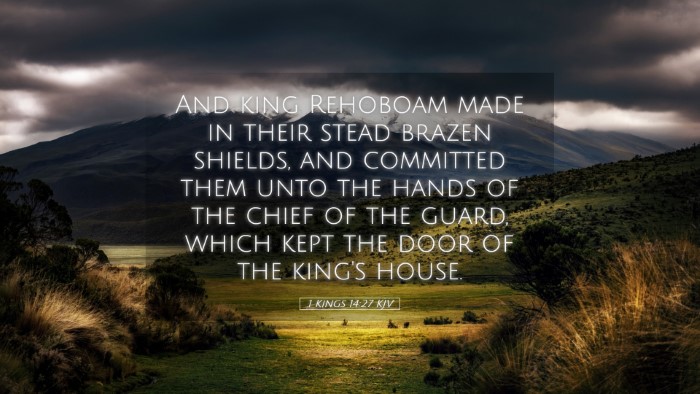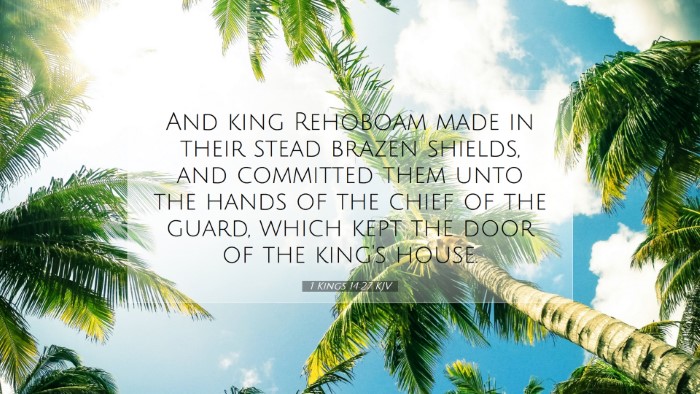Commentary on 1 Kings 14:27
1 Kings 14:27 (KJV): “And King Rehoboam made in their stead brazen shields, and committed them unto the hands of the chief of the guard, which kept the entrance of the king's house.”
Contextual Overview
The verse is set within the narrative of King Rehoboam's reign over Judah following the division of the kingdom. After Jeroboam led the ten tribes of Israel away, Rehoboam sought to establish his reign and fortify his kingdom against external threats. The shields mentioned in this passage were likely a response to the vulnerability perceived after the loss of the gold shields that had originally belonged to Solomon. This commentary draws insights from various prominent theologians and scholars.
Commentary by Matthew Henry
Matthew Henry elaborates on the significance of Rehoboam's decision to create brazen shields. He notes that the transition from gold to brass symbolizes the decline in both wealth and glory of the Davidic line. While Solomon's reign was marked by splendor, Rehoboam's actions demonstrate an attempt to maintain a facade of strength despite reduced means.
- Symbol of Decline: The brazen shields can be viewed as a representation of the deteriorating state of Judah. Where once there were golden shields of immense value, now there are lesser brass shields, signifying a shift not just in material wealth but also in spiritual fidelity.
- Military Preparedness: Rehoboam's commitment of the shields to the chief of the guard shows a focus on military readiness, which is critical in times of political instability. His approach reflects the need for strength in light of the threats posed by the secession of the northern tribes.
Henry emphasizes that the actions of leaders often illustrate their reliance on material means rather than on spiritual sources of strength and protection. Rehoboam’s reliance on visible defenses may also indicate a lack of faith in God’s protection for his kingdom.
Insights from Albert Barnes
Albert Barnes provides an extensive overview of the implications of Rehoboam's actions, suggesting that the reference to "brazen shields" reveals a shift in strategy. Solomon had previously used shields of gold, which were not only symbols of power but also represented divine favor and glory.
- Practical Response: Rehoboam's response was pragmatic; he sought to replace the lost shields to maintain the traditional appearance of royalty and authority. However, this decision may reflect poorly on his reliance on material wealth for security.
- Covenant Relationship: Barnes underscores that the covenant relationship with God was foundational to Israel's strength. Rehoboam's failure to heed this spiritual dimension may lead eventual deterioration, as physical shields alone cannot protect from divine judgment.
In sum, Barnes urges readers to recognize that true security for a believer lies not in material defenses but in faithfulness to God’s covenant and obedience to His commandments.
Reflections from Adam Clarke
Adam Clarke's commentary emphasizes the historical context and the implications of Rehoboam’s actions in the broader narrative of Israel's history. Clarke suggests that the use of bronze instead of gold indicates a significant decline in divine favor and blessing upon Rehoboam's reign.
- Maintaining Appearances: Clarke interprets the king's desire to maintain symbols of power as emblematic of a leader who understands the importance of image but lacks spiritual insight. The brazen shields represented a superficial attempt to project strength.
- Guardianship: The assignment of these shields to the chief of the guard illustrates a managerial approach to leadership, focusing on external threats rather than internal spiritual decay. The emphasis on the guard speaks volumes about Rehoboam's priorities.
Clarke concludes by reminding readers that while human schemes may seek to establish security, the true welfare of the nation lay in faithfulness and adherence to God’s laws.
Theological Implications
Rehoboam’s creation of brass shields can serve as a powerful metaphor for contemporary believers and church leaders. The act demonstrates a reliance on human strength and material possessions rather than spiritual integrity and reliance on God. The brazen shields became symbols of the heart’s condition – trusting in things that have no eternal value.
- Spiritual Reliance: Leaders today must evaluate their own foundations for strength and security. Are they analogously relying on "brazen shields," such as financial resources, charismatic leadership, or political connections, instead of on the unwavering promises of God?
- Symbolism of Decline: The degradation from gold to brass serves as a cautionary tale about the gradual decline of spiritual zeal and faith within a community. A focus on present appearances can lead to neglecting the deeper need for faithfulness and divine relationship.
- Guard the Heart: Just as the guards protected the king's entrance, believers are called to guard their hearts and minds against complacency, relying wholly on God’s strength and power.
Conclusion
The commentary on 1 Kings 14:27 offers rich insights into the complexities of leadership, the significance of symbolism in Scripture, and the underlying spiritual truths relevant to today's believers. Rehoboam's actions serve as both a historical account and a spiritual lesson. By examining the transition from materials of great worth to those of lesser value, we are reminded of the eternal principles that govern our true security and strength: faithfulness to God, obedience to His Word, and reliance on His divinely provided protection.


